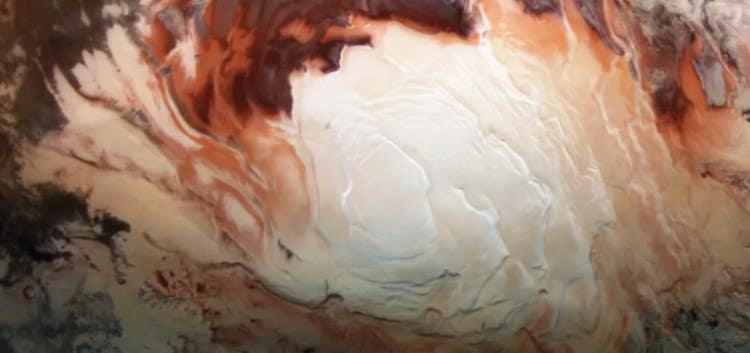NASA researchers find dozens of lakes beneath its south pole
Either liquid water Is common beneath Mars’ South Pole, or these signals are indicative of something else.

[June 28, 2021: Mike Wall]
The bright white region of this image, captured by Europe's Mars Express spacecraft in December 2012, shows the icy cap that covers Mars’ south pole, composed of frozen water and frozen carbon dioxide. (Image credit: ESA/DLR/FU Berlin/Bill Dunford)
Much more liquid water may lie beneath the south pole of Mars than scientists had thought — or there may be something going on down there that they don't fully understand.
In 2018, researchers analyzing radar data gathered by Europe's Mars Express spacecraft announced they'd found evidence of a big subsurface lake in the Red Planet's south polar region. The lake appears to be about 12 miles (19 kilometers) wide, and it lies about 1 mile (1.6 km) beneath the dry, frigid surface, the scientists reported.
The same core research team soon followed up on the find, using the same Mars Express instrument — Mars Advanced Radar for Subsurface and Ionospheric Sounding, or MARSIS for short — to study the subsurface in a wide area around the apparent lake. This work turned up evidence for three more underground lakes, each of them about 6 miles (10 km) wide, the scientists reported in a study last year.
Now, a different team has taken a very deep dive into the data. Arizona State University doctoral student Aditya Khuller and MARSIS co-principal investigator Jeffrey Plaut, of NASA's Jet Propulsion Laboratory (JPL) in Southern California, analyzed 44,000 observations MARSIS made of the Martian south polar region over 15 years. (MARSIS was built by the Italian Space Agency and JPL.)
The duo found dozens of radar reflections similar to the four that have been interpreted as buried lakes, over a wide range of horizontal and vertical distances. But many of the newfound signals were spotted relatively close to the surface, in places seemingly too cold to support liquid water — even the briny stuff hypothesized to exist in the Martian underground.
"We’re not certain whether these signals are liquid water or not, but they appear to be much more widespread than what the original paper found," Plaut said in a statement. "Either liquid water is common beneath Mars’ south pole, or these signals are indicative of something else."
What's unusual about the new findings is that some of the identified spots are less than a mile from the surface and estimated to be minus 81 degrees Fahrenheit (minus 63 degrees Celsius). That's so frigid even extremely salty water would freeze. The previous studies had suggested a high salt content could explain why the water remained liquid despite the cold polar temperatures.
The colored dots represent sites where bright radar reflections have been spotted by ESA’s Mars Express orbiter at Mars’ south polar cap. Such reflections have previously been interpreted as subsurface liquid water, but their prevalence and proximity to the surface suggests they may be something else. (Image credit: ESA/NASA/JPL-Caltech)
Another idea is that recent volcanic activity deep below the surface could be keeping water warm enough to stay liquid. Lead author Aditya Khuller, a formerJPL intern, addressed this concept: "However, we haven't really seen any strong evidence for recent volcanism at the south pole, so it seems unlikely that volcanic activity would allow subsurface liquid water to be present throughout this region."
"However, we haven’t really seen any strong evidence for recent volcanism at the south pole, so it seems unlikely that volcanic activity would allow subsurface liquid water to be present throughout this region," Khuller said in the same statement.
Neither Khuller nor Plaut can explain what exactly the newfound MARSIS reflections mean. But they hope their results, which were published online last week in the journal Geophysical Research Letters, will not remain mysterious for long.
"Our mapping gets us a few steps closer to understanding both the extent and the cause of these puzzling radar reflections," Plaut said.
Like these kind of feel good stories? Get the Brighter Side of News' newsletter.
Tags: #New_Discovery, #Space, #Mars, #Water, #The_Brighter_Side_of_News



